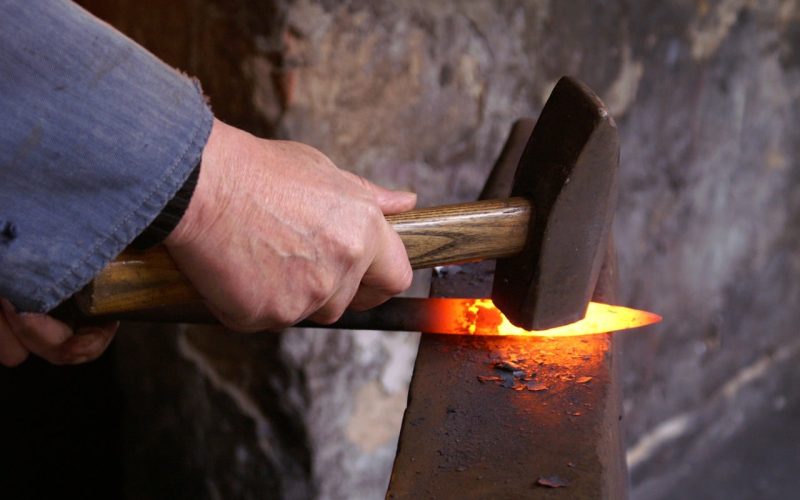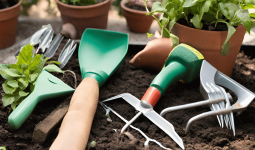If you’re an avid DIYer, chances are you’ve come across the term forging and aren’t sure exactly what it means, let alone how to do it properly.
There are different types of forging tools. Forging tools shape and cut metal, making them essential to many different manufacturing and construction processes.
Although there are different types of forging tools, most fall into one of four categories: direct drive, indirect drive, rotary hammer, and hydraulic transfer punch presses.
In this article, you’ll learn everything about forging, including why and how to do it and the different forging tools best suited for your next project.
Read on to learn everything you need about the incredible generating world!
1. Forging Dies
Forging dies serve a specific purpose, such as extruding and spinning. One type of forging die is a press die.
Press dies have a hefty cutting edge. They push through metal to form shapes like bends, curves, angles, and rolls.
They’re often shaped into cylinders with tapered ends called shears or punches to cut metal away.
This die removes unwanted material after punching down sheets into flat parts or forming hot wire slices into pieces with holes.
Another forging due is the open die. The open die forging process involves shaping a piece by striking it from one side and pushing it out from the other side.
The sheet is held securely on one side while being hit from the other.
Punching and shearing die come in various sizes, from small handheld tools to huge ones used in industrial forging.
Some die work only in specific directions, while others are reversible to push through metal in either direction.
Other types of forging dies may do nothing more than add decorative elements to your projects or serve as finishing touches.
For example, one type you may use on special occasions is a collar die that forms collars onto headings or bookends that loop around bolts or screws.
2. Set Hammer
The hand-held forging hammer is one of the different forging tools in various shapes and sizes.
The design affects how you use it and the result you can create. When choosing one, consider how much strength you want to put into your blows.
Also, what type of material are you working with? Will you be striking in sequence or alternately? Are any additional handles needed to reduce fatigue?
If a hold is necessary (it often is), your options include using an outstretched arm as an extended handle or leaning over at an angle so that your upper body bears part of the weight.
It is used mainly for making surface planes and forming corner radii. It comprises the hammer and its steel face plate clamped in metal.
The smith would strike small areas on the workpiece by putting pressure on them with their hand or a tool.
Tools such as a chasing hammer or ball peen hammer are used to maintain contact between the two pieces of the set hammer.
Hammering may also be done without tools by simply using pressure from one’s hands. This process is called drawing down.
3. Clamping Vice

A clamping vice is a machine or tool that secures objects with vise-like jaws. It’s typically used in manufacturing with the right one.
You can have at-home power to craft or restore any household item.
Clamping vices are a different forging tool that provides stability without sacrificing flexibility.
That means you can work on shapes and areas where other types of clamps would be impossible, such as round tubing and curved steel.
Because we know your projects are one-of-a-kind, we want to ensure you find a perfect clamping vice for your needs.
4. Swage Block
A swage block is a piece of equipment that is used in metalworking. It has several punches on its face, corresponding to different-sized holes on the opposite side.
These punches can be hammered into those holes and withdrawn when used correctly. Then, form a round bar with the desired shape and cross-section.
Also, swage blocks are often used when making pieces requiring complex conditions or fitting large diameters into small areas.
The amount and variety of fixtures you will need depend mainly on what you are trying to make, including what metals you will be working with.
It’s common for a shop always to keep many different sizes and shapes in stock.
5. Flatter
The flatter is arguably one of the most essential and versatile tools in a blacksmith’s toolbox among the different forging tools.
It has many different uses, such as:
- Flattening metal
- Adjusting steel to right angles
- Decorating metal with punches and chisels.
- Twisting (torsion) metal.
- Demagnetizing or magnetizing steel parts by bringing them together or spreading them apart, respectively (a friction stir welding technique).
- Propping up heavy metal sections so they can be welded without sagging under their weight.
6. Swage
Swages are typically made from copper or bronze. They range from simple bolt-forming swages to more complex types like taper and threading swages.
They’re made in various sizes that correspond to the bolt diameters, so you can make all sorts of shapes depending on your needs.
The most common type is bearing swage. This tool upholds materials while you form them with your punch by pushing through them.
They’re worth investigating if you’ve never had to use a swage before!
7. Punch and Drift
Since the 1800s, punch and drift tools have been used to create everything from delicate hand-forged steel jewelry to enormous railroad components.
Punching and drifting create various shapes that can be used in other types of forge work, such as ornamental ironwork, forging a leaf on a curtain rod, or shaping handlebars on a bike.
A punch tool, like an ice pick, is made from tempered high-carbon steel.
A hammer drives the punch tool into the metal, creating an indentation or pattern that can then be shaped by drift or another punch tool.
8. Fuller
A fuller tool is among the different forging tools used to sharpen and clean metal surfaces.
The top end is beveled, allowing it to work like a large file. Sometimes, the face or helping side can also be beveled.
A fuller helps a smith create an even and well-defined edge on tools, shapes, or plates.
The face side can also be a counterweight in hands-on or powered hammering methods.
9. Hammer
The most common type of forging tool, a hammer, is essential to any blacksmithing kit.
Hammers are primarily used to shape hot metal into various shapes. Unlike more durable metals like titanium and brass, they’re often forged from steel.
While many hammers look relatively similar at first glance, there are significant weight and weight distribution differences.
The weight will affect your productivity when forming and shaping metal.
A lot goes into purchasing a hammer. High demand for customer satisfaction can make or break your next blacksmithing project.
Additionally, there are types of hammers:
- Drop-hammers: These hammers forcefully drive down onto the hammer’s head using kinetic energy. They work well for heavy-duty jobs requiring much power to be applied quickly. When using this hammer type, you want to strike downward with all your might. Using an up-and-down motion will not generate enough force for this task.
- Hammer and punch: These tools are helpful when you need to pound something (usually sheet metal) flat against an object (like an anvil). Many people prefer using them over tongs. They provide more stability than pinchers while still being able to squeeze tightly so they won’t slip off whatever they’re holding onto.
- Power hammer: Sometimes called drop hammers, these are usually powered by electricity, hydraulics, or steam. These machines feature a heavy weight attached to a long arm that pulls down on the opposite end, delivering immense force. Power hammers come in different shapes and sizes depending on their intended purpose. Some may be designed for general blacksmithing tasks, while others specialize in working with specific materials such as aluminum.
10. Tong
For many professional blacksmiths, tongs are among the different forging tools they use daily.
The primary purpose of a tong is to hold an object securely while striking it with another tool, typically a hammer.
Tongs come in many different styles and shapes to best suit whatever you need to do at that moment.
Some tongs allow you to grip an object and move it closer or farther away from your forge as required.
These types are typically called live hand tongs. Another type of tong that is more common among professionals is ratchet-grip tongs; these allow you to work continuously on pieces such as horseshoes and nails by moving them forward with each stroke, increasing your production exponentially.
11. Chisel
A chisel is a forging tool that cuts and shapes metal, wood, or other hard materials. It is a bladed instrument with a long handle attached perpendicular to the cutting edge.
The chisel can be made from any rigid material, such as steel, iron, stone, plastic, or ceramic. The handles vary in size and style depending on what function they are intended to perform.
For example, a typical riveting chisel will have an octagonal-shaped handle that fits into one’s palm like the handle on a hammer.
12. Furnace or Hearth
Forging tools are a blacksmith’s bread and butter, making up the majority of their work.
Metal heated to specific temperatures is manipulated by hammers in the right spots to create any number of things.
A furnace or hearth is among the different forging tools used in blacksmithing to heat metal at high temperatures.
The metal is then hammered into the desired shape with a hammer.
As you might expect, this process requires patience and skill, especially since the furnace or hearth must always maintain the high temperature required for shaping metals.
Several furnaces are available for coke-fired open hearths and coal-fired closed systems.
One common difference between these two types of furnaces is that coal fires burn hotter than coke fires.
This makes them ideal for heavier work like horseshoes and railings, where more strength is needed from the metal being forged.
Some believe it may also contribute to better corrosion resistance than coke-fired units.
13. Anvil
An anvil is one of the most essential tools in your arsenal of different types of forging tools.
This is not just because it looks fantastic. An anvil can take a lot of weight, and it is easy to move around because it is light.
This means you can forge all day without worrying about hurting your back.
The size and shape of the anvil depend on what you’re going to do with it.
However, more miniature anvils will do more precise work, while larger ones will take heavier loads.
14. Bick iron
Bickiron is one of the different forging tools found at the center stage in most blacksmith shops.
It’s a versatile metal that can be forged into a wide range of products. So it’s worth learning how to develop with back iron.
Bick iron comes in various shapes and sizes, which may look confusing when starting. But after some practice, you’ll find it’s not as hard as it seems.
The size and shape will depend on what kind of forging project you’re working on and your preference.
Typically, back irons are flat or round bars with diameters from 0.5 inches to 2 inches.
15. Press
Press forging equipment uses excessive pressure to fold metal into the desired shape.
That said, it is not considered one of the more versatile tools in your arsenal.
One way to use this tool effectively is if you need to give someone a small gift, such as jewelry or cufflinks.
Presses have come in various shapes and sizes; some are explicitly designed for jewelry making! There are different types of press forging; these are:
Mechanical press forging: It’s recommended that beginners start with it. This is because it doesn’t require much skill and will allow you to explore without getting too deep into the details.
Unlike other forms of pressing, this process requires less brute force and relies heavily on mechanics, which makes it very efficient.
It is perfect for beginners who want to learn how forging works before they tackle any other form.
While they may be easier than different types of presses, don’t let their simplicity fool you. They produce high-quality results!
Hydraulic press forging: If you’re looking for something more substantial and aggressive, hydraulic press forging is the correct route.
Like mechanical presses, they rely on mechanics and sheer power to quickly finish the job.
They’re an excellent option for those who plan on doing large-scale projects that require extra force.
However, keep in mind that they need plenty of experience to operate successfully due to their sheer size and potential risk factors (such as fluid leakage).








